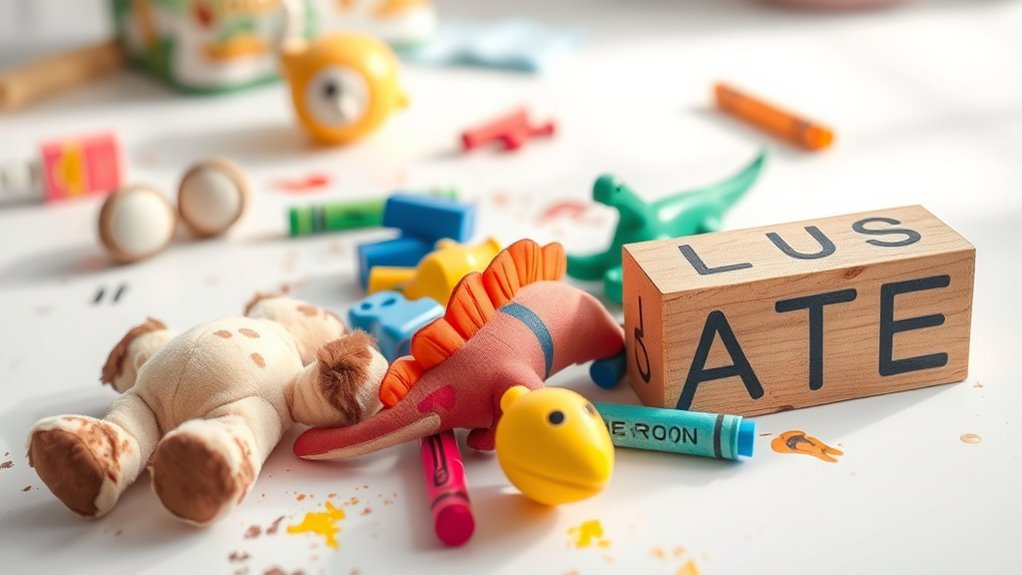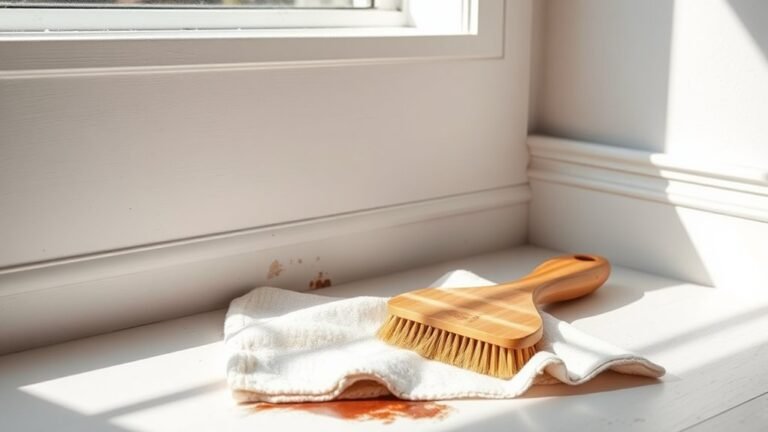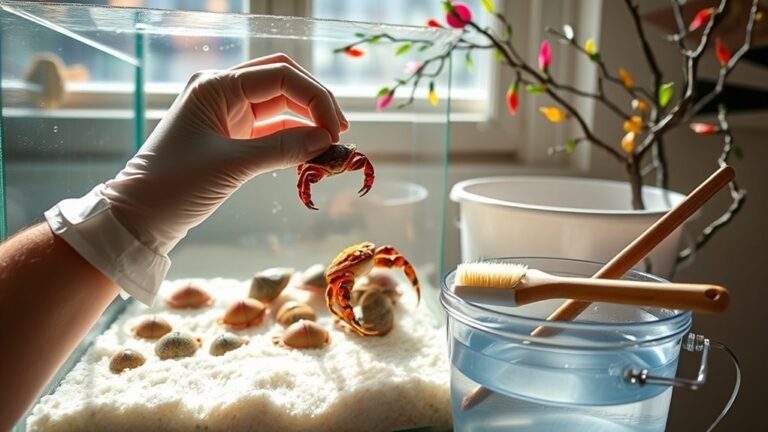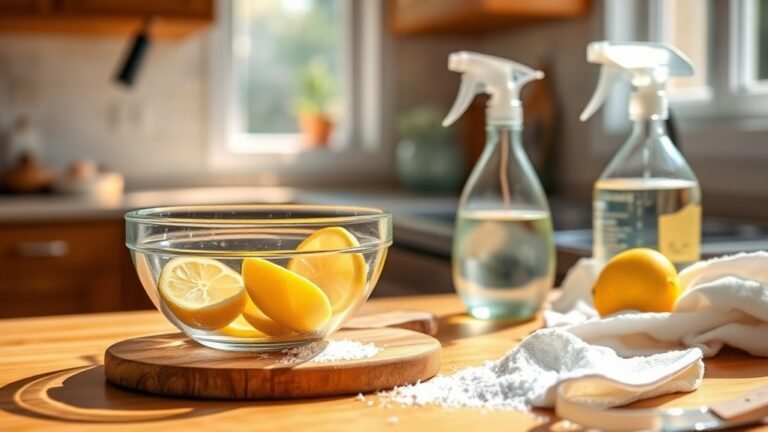How to Remove Stubborn Stains From Toys
To remove stubborn stains from toys, first identify the stain type—paint, food, or dirt—to choose the best cleaning method. For plastic or vinyl toys, use gentle solutions like diluted vinegar or mild soap to avoid damage. Stuffed toys respond well to spot cleaning with mild detergent or rubbing alcohol for ink stains. Natural ingredients like baking soda paste effectively lift grime. Regular wiping and quick spot cleaning help prevent stains from settling. Keep exploring to find even more helpful tips.
Identifying Different Types of Toy Stains

When you’re tackling toy stains, the first step is figuring out what kind you’re dealing with. Paint stains often sit stubbornly on the surface, sometimes dried and tough, demanding a bit of patience. Food stains, on the other hand, can be sticky or oily, and they might soak into crevices or fabric parts of toys. Knowing the type of stain helps you choose the right approach without wasting time or risking damage. You want freedom from frustration, not to be trapped by trial and error. Recognizing whether it’s paint stains that need gentle scraping or food stains that call for a different tactic empowers you to act confidently and keep those toys looking fresh and inviting.
Safe Cleaning Solutions for Plastic and Vinyl Toys
Although plastic and vinyl toys are durable, you’ll want to use gentle cleaning solutions that won’t cause damage or discoloration. Choosing eco friendly solutions lets you keep toys safe for kids and the planet. Simple mixtures like diluted white vinegar or baking soda paste work wonders on stains without harsh chemicals. For disinfecting, opt for safe disinfectants such as alcohol wipes or a mild soap and water combo. Avoid bleach or abrasive cleaners that can eat away at the toy’s surface. By sticking to these gentle, effective options, you maintain the toy’s look and lifespan while freeing yourself from worry about toxic residues. Cleaning your child’s favorite plastic or vinyl toys doesn’t have to be complicated or harmful—it just takes the right, safe approach.
Techniques for Removing Fabric and Stuffed Toy Stains

Dealing with stains on fabric and stuffed toys requires a careful approach to protect their softness and colors. You’ll want to choose stain removal techniques that are gentle yet effective. Always test a small, hidden area first. Fabric cleaning methods like spot cleaning with mild detergent or using a soft brush can lift stains without damage. Avoid harsh scrubbing to keep the toy’s fibers intact.
| Stain Type | Recommended Technique |
|---|---|
| Food stains | Dab with mild detergent |
| Ink stains | Use rubbing alcohol gently |
| Dirt/mud stains | Soft brush and water mix |
Using Natural Ingredients to Tackle Tough Stains
Natural ingredients offer you an effective and safe way to remove tough stains from toys without harsh chemicals. When you choose natural cleaning, you’re embracing eco friendly solutions that protect both your family and the environment. Simple items like baking soda, white vinegar, and lemon juice can work wonders. For example, a paste of baking soda and water gently lifts grime, while white vinegar breaks down stubborn residue. Lemon juice adds a natural bleaching effect, brightening faded spots. You don’t need to rely on toxic products to get toys clean. By using these natural ingredients, you maintain freedom from harsh chemicals and reduce waste. Plus, they’re easy to find and budget-friendly. With natural cleaning, you keep your home safe and your toys looking fresh.
Preventative Measures to Keep Toys Stain-Free

Using natural ingredients to clean toys is a great step, but preventing stains from forming in the first place will save you even more time and effort. By adopting simple toy maintenance tips, you can keep your toys looking fresh and vibrant, giving you more freedom to enjoy playtime without constant cleaning.
| Tip | Action | Benefit |
|---|---|---|
| Regular wiping | Use a damp cloth daily | Stops dirt buildup |
| Designated play areas | Limit messy snacks | Reduces spill stains |
| Quick spot cleaning | Tackle spots immediately | Prevents deep stains |
| Safe storage | Keep toys dry and covered | Avoids mold and grime |
| Routine checks | Inspect for damage/stains | Maintains toy quality |
Stick to these stain prevention habits, and you’ll save time while keeping toys stain-free and ready for fun.
Frequently Asked Questions
Can Stain Removal Damage Toy Paint or Decals?
Stubborn stains sometimes sabotage surfaces, so you’ve got to select suitable stain types and cleaning methods carefully. If you’re not cautious, harsh chemicals or abrasive scrubbing can damage toy paint or decals, stripping away their charm. You want to safeguard your toy’s style while seeking stain solutions. Always test cleaners on a small spot first and opt for gentle, freedom-friendly methods to keep your toys looking fresh without fear of fading or peeling.
How Often Should Toys Be Deep Cleaned for Stains?
You should set a toy maintenance schedule that fits your lifestyle but aim for a deep cleaning frequency of every 1 to 3 months. This keeps toys fresh without overdoing it, preserving their look and function. If toys get heavy use or exposure to dirt, clean them more often. Staying consistent with this routine guarantees you enjoy freedom from stubborn stains and messy buildup, making playtime hassle-free and fun.
Are There Specific Stain Removers for Wooden Toys?
When it comes to wooden toys, you don’t want to throw the baby out with the bathwater. There are specific stain removers designed just for wood, often based on natural cleaners like vinegar or baking soda. These eco friendly options gently lift stains without harming the wood or your child’s health. You’re free to keep toys looking fresh while staying green, so you can clean confidently without harsh chemicals.
Can Mold Form Under Stains if Not Cleaned Properly?
Yes, mold can definitely form under stains if you don’t clean toys properly. To avoid this, you should focus on mold prevention by regularly cleaning your toys and not letting moisture linger. Keeping a good cleaning frequency helps guarantee no hidden damp spots develop, which mold loves. You want your toys fresh and safe, so staying on top of cleaning routines gives you the freedom to enjoy them without worrying about hidden mold hiding beneath stains.
What’s the Best Way to Dry Toys After Cleaning?
Imagine your toys basking in a gentle breeze, like leaves swaying freely under the sun. For the best air drying methods, place them on a clean, dry towel in a well-ventilated space—nature’s way of setting them free. If time’s tight, drying alternatives like a fan can speed things up without trapping moisture. You want your toys dry and fresh, ready to embrace playtime again without lingering dampness holding them back.






